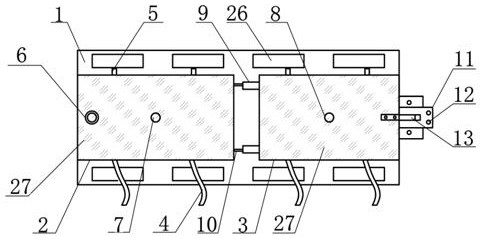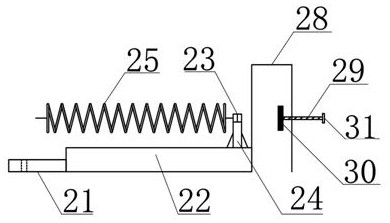A bedside active exercise device for neurosurgery
The technology of an exercise device and a surgical bed is applied in the field of neurosurgery medical equipment, which can solve the problems of general passive exercise effect and large workload, and achieve the effects of increasing muscle strength and joint mobility, improving safety, and promoting blood circulation.
- Summary
- Abstract
- Description
- Claims
- Application Information
AI Technical Summary
Problems solved by technology
Method used
Image
Examples
Embodiment 1
[0027] Such as Figure 1-8As shown, a neurosurgery bedside-in-one, including a base 1, a base 1 for supporting the first casing 2, the second shelter 3, and the upper limb weight, and the base 1 side is symmetrically provided with a weight block 26. The weight of the base 1 is increased, preventing the upper limb strength from being lifted by excessive upper devices, and the weight block 26 is connected to the base activity through the screw, and can be removed or installed as needed. On both sides of the base 1 below the weight block 26, there is a support leg, and the number of support legs is not less than two. When using the device, the leg can increase the stability of the entire device, and the support leg is connected to the base 1. The rotating leg is opened to support or rotate to the base 1 to save space. The base 1 is provided with a first casing 2 and a second casing 3, wherein the first casing 2 is used to fix the rear arm of the upper limbs, the second shelter 3 is us...
Embodiment 2
[0031] When using a neurosurgery bed bypassing the active exercise device to fix the upper limb 2 and the first casing 2 is fixed to the base 1, fix the second casing 3 and the base 1, put the rear arm of the upper limb Inside the first cassette 2, the rear arm of the upper limb is placed in the second cassette 3, and then the strap 4 passes through the buckle 5 and is fixed to the buckle 5, and the fixation of the upper limbs can be reduced. The upper limbs that can be self-active have caused the risk of upper limb injuries when unintentional chaos, and can improve the patient's autonomous upper limb safety.
Embodiment 3
[0033] When using a neurosurgery bed bypassive active exercise device, an upper arm contraction of the upper limbs is extended. When the active exercise is used: use the screw to fix the first casing 2 on the base 1, the second casing 3 is not fixed with the base 1, and the elasticity The damper device 25 is connected to the connecting hole 14 and the collar 23, respectively, and the support plate 22 is fixed to the bed tail through the casing 28, and the rear arm of the upper limb is placed in the first shelter 2, put the back arm of the upper limbs in the first Inside the bracket 3, then pass the straps 4 through the buckle 5 and fix it on the buckle 5, hold the anti-slip sheath on the handle, and do shrinkage, stretch the movement, and pull through the second shelter 3 Stretch, release the elastic damping device 25, to contract, extend exercise, to achieve muscle strength, three muscle, elbow joints such as upper limbs and joint activity exercise, promote blood circulation of u...
PUM
 Login to View More
Login to View More Abstract
Description
Claims
Application Information
 Login to View More
Login to View More - R&D
- Intellectual Property
- Life Sciences
- Materials
- Tech Scout
- Unparalleled Data Quality
- Higher Quality Content
- 60% Fewer Hallucinations
Browse by: Latest US Patents, China's latest patents, Technical Efficacy Thesaurus, Application Domain, Technology Topic, Popular Technical Reports.
© 2025 PatSnap. All rights reserved.Legal|Privacy policy|Modern Slavery Act Transparency Statement|Sitemap|About US| Contact US: help@patsnap.com



